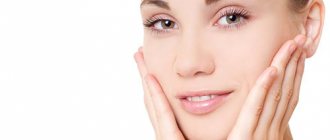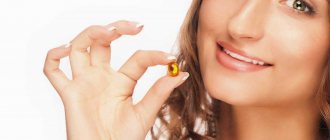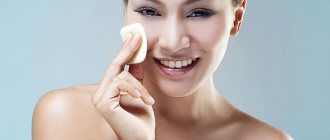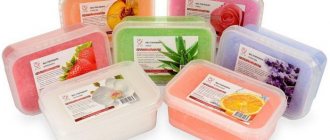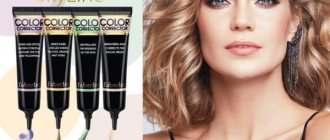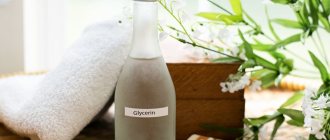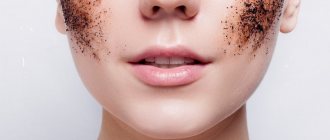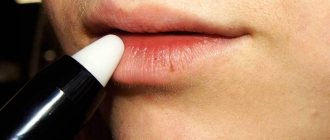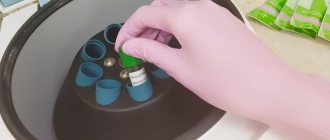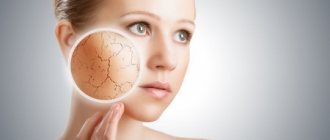Glycerin is widely used in the medical, cosmetology and food industries as an important component. Glycerin is used to create creams, masks, lotions and other cosmetics that you can prepare yourself at home. Therefore, it will not be superfluous to learn the methods of use, properties, positive and negative features of the useful substance.
Glycerin - what is it?
Glycerol
is a moisture-retaining substance from the class of trihydric alcohols, which is widely used in the cosmetics industry and is part of moisturizing, softening and anti-aging products. The chemical formula of glycerin consists of three water molecules, which explains its hygroscopic ability to absorb water molecules from the air, accumulate them in cells and prevent transepidermal moisture loss.
Glycerin in its pure form is a syrupy, clear liquid with a sweetish taste. The component gained its popularity in cosmetology due to its low cost and high efficiency. Glycerin for the face can be found in the basis of the formulas of various cosmetic products: emulsions, creams, gels, masks, soaps and is suitable for caring for problematic and sensitive skin types.
There are several ways to make glycerin: plant, animal and synthetic production. Let's take a closer look at its forms.
Natural (natural) glycerin
In nature, the substance is found in oils and fats: animal glycerin is made from pork fat, vegetable glycerin is a derivative of palm oil, coconut oil is the most accessible and safe. The plant-based production method is the most common and is considered more environmentally friendly. It is natural vegetable glycerin that is used in cosmetology and pharmacology and is characterized by high quality and safety.
Synthetic glycerin
The industrial production method is the synthesis of glycerin from propylene. There are two synthesis technologies: the chlorine method (by chlorination of propylene) and the chlorine-free method (oxidative method through acrolein). The synthetic form of glycerin has a low degree of purity and is most often used for technical purposes.
Description and classification
Glycerin is a chemical substance (trihydric alcohol) obtained by processing fats. It is divided into 2 types: plant and animal origin. The latter is used when creating cosmetics.
There are two more varieties:
- synthetic;
- natural.
Many cosmetologists recommend using natural ones, although recent research by scientists has proven that these types are no different from each other, and in some cases it is quite difficult to accurately determine the identity of the substance.
In any case, the formation of a substance occurs as a result of a chemical process. This division is conditional, and the properties of both types are the same.
Use of glycerin for skin
In cosmetics
In skin care products, glycerin not only plays the role of a skin moisturizer, but also effectively fights the signs of early aging: smooths out wrinkles, increases skin elasticity and firmness. Cosmetics with glycerin are a good way to provide a lifting effect to the skin at home.
Due to its beneficial properties, this ingredient is often found in the basis of cosmetic formulas of natural and pharmacy products in combination with vitamins, hyaluronic acid, peptides, and vegetable oils. Glycerin is a common component in the basis of emollient and nourishing body products, some sunscreens, and shower gels. The basis of cosmetic formulas is Glycerin.
In cosmetology
In cosmetology, natural glycerin is most often found in the base of skin masks, caring and intensely moisturizing creams, and softening lotions. Such products are used at different stages of comprehensive care for dry, oily and mature skin. Check with your cosmetologist which mask recipes contain glycerin.
In pharmaceuticals
The well-known solution of pure glycerin is used in medicine as an antiseptic, emollient, moisturizer, and healing agent. Most often it is used to accelerate the healing of wounds and prevent their infection and suppuration.
Method 5 for shine
To give your car a shine not only inside, but also outside, try diluting glycerin with water in the following proportion:
- 200 ml water;
- 40 ml glycerin.
The mixture must be applied to the cleaned surface of the car. After the next wash of your favorite car, dampen a slightly clean rag in the freshly prepared solution and cover the entire surface of the car, including the windows, with the mixture. Minor scratches will disappear from the surface of the body, and the paint will noticeably freshen, even the matte finish begins to shine in the sun. This product will help extend the life of your car's paintwork.
It is better to polish a car at above-zero temperatures and indoors.
Benefits of glycerin for facial skin
- Moisturizes
Glycerin creates a film on the surface of the epidermis, strengthening and restoring the hydrolipid layer. Moisturizes by literally attracting water molecules from the air and helping to retain it in the dermal layers of the skin, preventing tissue dehydration. It is important to remember that hygroscopic glycerin applied to the skin in its pure form can also dry out and cause a feeling of tightness of the epidermis, provided that the ambient humidity level is below 45%. Accordingly, the higher the air humidity, the better the substance works. - Softens
Another important property of glycerin for skin is softening. The component has a pronounced dermatoprotective effect, improves the mechanical properties of the epidermis, softens the skin and minimizes peeling, penetrating into the deep layers of the epidermis. - Renews
Glycerin also accelerates cell regeneration, promotes rapid healing of skin damage, relieves inflammation and irritation. - Protects
By strengthening the hydrolipid mantle, glycerin also strengthens the barrier properties of the skin and increases its resistance to negative environmental influences. The antiseptic properties of the substance help cells resist pathogenic bacteria and microbes. - Smoothes wrinkles
Thanks to its powerful moisturizing properties, glycerin nourishes the epidermis with moisture, filling and smoothing out dehydration creases and expression wrinkles.
Softening fabric after washing
The properties of glycerin make it a universal product for everyday use. For example, if a product has become rough after washing, you can soften it in the following way:
- After washing, do not dry the items, but place them in a container with water and glycerin diluted in it for 20 minutes. For 3 liters of water, 5 g of the substance is used;
- After this, you need to rinse the laundry in a solution of water and ammonia (1 teaspoon of alcohol per 1 liter of water).
The item will become softer to the touch.
Indications for the use of cosmetics with glycerin
Let's look at in what situations and for what skin imperfections it is appropriate to use glycerin in cosmetics.
- Dry skin: due to a genetic characteristic or caused by improper care.
- Dehydration and flaking, for example, due to improper care of oily and problematic skin using alcohol-containing, acidic products or aggressive alkalis.
- Loss of radiance and dull complexion.
- Photoaging caused by decreased moisture and skin damage due to prolonged exposure to sunlight.
- Expression wrinkles, dehydration creases.
- Small cracks, irritation, inflammatory foci, for example, against the background of recurrent acne.
Pollution from fatty foods
How to use glycerin to the maximum in everyday life? Use to get rid of traces of grease on any fabrics and surfaces of upholstered furniture.
To remove canning and fish stains, you need to wipe the area with a soap solution, then soak the fabric in heated glycerin and leave for an hour. Then wash or rinse the item.
You can get rid of a stain on the sofa by dissolving 10 ml of ammonia and glycerin in a glass of water. After saturating the surface with the composition, you should place a clean white cloth on it (it is better to take satin or chintz) and iron the contaminated area with an iron.
Features of using cosmetics with glycerin for different skin types
How does glycerin affect the condition of the skin in the presence of possible imperfections? Let’s look at what effect the component in cosmetics has on different skin types and the specifics of its use.
- For oily and problematic skin
It is found in moisturizing non-comedogenic gels or lotions that protect the skin from dehydration. It is also used as a basis for therapy against the background of temporary dry skin caused by aggressive components (alcohol, alkalis, acids) that are not suitable for oily skin types. - For the
dry type, the main client of glycerin for the face: the epidermis is permanently saturated with moisture, flaking is reduced, the feeling of tightness disappears, the protective properties and hydrolipid barrier are strengthened. Glycerin acts as a powerful humectant and restores softness and comfort to dry skin. - For normal and sensitive skin
Prevents dryness, dehydration, flaking. Thanks to its antiseptic and soothing properties, it relieves discomfort and irritation of the sensitive epidermis. Promotes accelerated regeneration of skin damage. Use with caution for reactive hypersensitive skin. - For combination:
Moisturizes the dry U-zone and protects against dehydration and its consequences of increased sebum production and skin thickening in the oily T-zone. - For mature skin
Increases hydration, elasticity, firmness of the skin, smoothes out visible creases of dehydration and wrinkles, has a lifting effect, strengthens, protects the epidermis.
Color change
To lighten by half a tone and maintain the selected shade, you can also use glycerin. How to make a mixture for transformation at home, we will find out further:
- Pour two tablespoons of chamomile flowers with hot water and leave for two hours. Strain the mixture and pour 60 ml of glycerin into it. Apply to hair, keep covered for 40 minutes, then rinse thoroughly.
- Beat an egg, add 10 ml of lemon juice, 50 ml of low-fat kefir, and pour in three tablespoons of heated glycerin. Distribute the product over damp hair for 30 minutes.
Which cosmetic products usually contain glycerin?
Most often, glycerin is found in the base of creams, masks (for skin and hair), fluids, lotions, gels, cleansers, some shampoos and hair conditioners. Many people mistakenly believe that glycerin is not used in serums, but this is not true. An example is Hyalu B5 Concentrated Anti-Wrinkle Serum from La Roche-Posay. Thus, natural (pure) glycerin in a concentration of up to 15% can be present in the base of any moisturizing, softening and anti-aging cosmetic products.
How to make a mixture for different bubbles at home
There are a lot of recipes for making soap bubbles, since usually successful mixtures are obtained experimentally.
A simple recipe with a minimum of ingredients
To prepare, you only need three components:
- soft water (boiled, melted or distilled) – 300 ml;
- “Fairy” detergent - 100 ml;
- glycerin - 50 ml.
Cooking process:
- Pour the required amount of warm water into the basin.
- Pour in Fairy.
- Add glycerin.
- Mix everything carefully without raising foam.
- Let it sit in the refrigerator for 24 hours.
The mixture is ready, you can blow bubbles.
A simple way to make soap bubbles - video
https://youtube.com/watch?v=7XxrsyFhFs8
Recipe using sugar and baking powder
We use the following components:
- distilled water - 300 ml;
- soap base - 50 ml;
- glycerin - 25 ml;
- granulated sugar - 5 teaspoons;
- baking powder - 1 teaspoon.
The process of preparing the mixture for soap bubbles:
- Pour sugar and baking powder into the bottom of the container.
- Add glycerin.
- Pour in detergent.
- Fill all components with water.
- Mix thoroughly without foam and leave to infuse for 12 hours.
After the soap film has become dense and solid, the bubbles are ready.
Soap bubbles with sugar - video
Recipe for giant soap bubbles
Ingredients and their proportions:
- distilled water - 400 ml;
- “Fairy” dishwashing liquid – 100 ml;
- glycerin –75 ml;
- sugar –5 teaspoons;
- gelatin – 5 teaspoons.
Cooking process:
- Soak the gelatin and let it swell.
- Strain the gelatin and drain off excess water.
- Melt the gelatin and sugar mixture on the stove, but do not boil.
- Fill everything with water.
- Add detergent and stir.
- Leave to infuse for a day.
The mixture made according to this recipe produces large and strong bubbles.
Giant soap bubbles - video
There are a huge number of recipes for making soap bubbles on the Internet. They are often similar in their set of components, less often in their proportions. The main thing in cooking is to follow the basic recommendations and be ready to experiment. There is no universal recipe for soap bubbles, find the one that suits you best and perfect it!
Review of cosmetics with glycerin La Roche-Posay
Effaclar Micro-Exfoliating Cleansing Gel for Face and Body
EFFACLAR GEL
Micro-exfoliating gel
Thanks to an active formula that combines two types of acids and components that restore skin balance, the gel gently but intensively cleanses and exfoliates the epidermis and does not contain scrubbing particles that can injure problematic skin.
RUB 1,290 buy
A product without abrasive particles, with zinc, salicylic acid and glycerin, fights imperfections and helps smooth out signs of post-acne: stagnant spots, scars. Intensively cleanses pores, mattifies and softens the skin.
Consumer reviews:
Alexandra: I was pleasantly surprised by the effect, after washing my face was fresh, smooth, as if it was exfoliating the skin without damaging it. I use it once a day at night, so far I like it!
Christina: A godsend for those with problem skin. A pleasant menthol smell and a cooling sensation on the skin, high-quality cleansing, which, combined with good hydration, will not cause dryness. The gel is delicate, there are no scrubbing particles, exfoliation due to acids. It’s difficult to judge the effect on post-acne, since I use external therapy in combination, but for basic daily care it’s excellent.
Lily: I use it on the face. A very delicate effect and at the same time effective. From the first wash, the pores narrowed, the skin was smooth, no redness or tightness. It suited me (my skin is oily, flaky, my pores are wide). I ordered a large quantity at once and did not regret it.
Moisturizing mattifying emulsion Effaclar Mat
EFFACLAR MAT
Mattifying sebum-regulating emulsion
Contains the Sebulyse component, which reduces sebum production, providing a mattifying effect and helping to tighten pores. Intensely moisturizes and prevents skin from dehydration.
RUB 1,714 buy
An emulsion with perlite and sebulise reduces oily shine, tightens pores, instantly mattifies the skin, prevents dehydration, does not dry out, but moisturizes the skin.
Consumer reviews:
Alexandra: I’ve been using it for over a month now. The product is very light, does not dry out the skin, moisturizes, mattifies for 4 hours, softens the pore pattern in the T-zone somewhat, does not clog pores, and is a good base for makeup. The aroma is very weak, subtle and quite pleasant.
Annet: It fits well, absorbs well, no stickiness or discomfort, it really evens out the tone, a great product, I advise anyone who uses this line of products to buy it, as the makeup base has proven to be excellent.
Toleriane Sensitive Rich Moisturizing Cream
TOLERIANE SENSITIVE
Moisturizing cream for sensitive skin
Moisturizes, soothes, enhances the natural protective function of the skin.
RUB 1,111 buy
Cream for dry sensitive skin with a nourishing formula with prebiotics, niacinamide, shea butter normalizes the skin microbiome, moisturizes, soothes, softens, strengthens, and protects the skin.
Consumer reviews:
Alena: I’m very pleased with the cream. If you use it at night, then in the morning the skin will feel like after a mask, it will perfectly nourish and moisturize. In my opinion, it is ideal for the cold season, and also creates a certain barrier. It has a dense texture, easy to apply, I recommend it for dry and sensitive skin. No smell! What is very important for me, I will continue to order it, it is quite economical, lasts for a couple of months.
Sharafutdinova: The cream is good. The problem I had was that my skin was dry and the creams were not absorbed, I tried different creams. After consulting with a doctor, I bought this cream, I use it, I am very pleased. Absorbs, moisturizes, does not leave a film.
Effaclar Purifying Mattifying Mask
EFFACLAR
Purifying mattifying mask
Absorbs excess sebum, deeply cleanses, helps tighten pores and thereby has a mattifying effect, and also controls sebum production.
RUB 1,167 buy
A mask with kaolin and panthenol cleanses pores well of all types of impurities, controls sebum synthesis, mattifies the skin, does not dry out, and does not cause a feeling of tightness or discomfort. Calms inflammation, relieves redness, promotes tissue regeneration.z>
Consumer reviews:
Olga: I really liked the mask. Copes with all the tasks set in the description of this product. very economical to use. I recommend!
Valeria: An excellent mask for deep cleansing problem skin. Cleanses very well and does not dry out the skin. Pleasant texture, very economical, excellent price, I will buy more!
Lily: Very pleasant, homogeneous consistency, the pores immediately seem to be smoothed out, becoming less noticeable and deep. Treatment has become an interesting procedure, every time I get an immediate effect.
Beautiful hair is easy
To have chic and shiny curls, hairdressing professionals also recommend using glycerin. Beauty salon experts tell you how to use this product for your hair.
Firstly, it should be noted that glycerin does not allow both the hair scales and the scalp to dry out. Secondly, it cleans the surface of dirt and cosmetic compounds. Thirdly, the product helps the strands become obedient. The constant use of glycerin makes it easier to comb, thickens curls, gives elasticity and shine, removes dandruff and static effect. However, girls with dark hair should keep in mind that formulations with glycerin may slightly lighten the curls.
There are a number of hair masks that improve their condition:
- To moisturize, you need to take glycerin and gelatin in a 2:1 ratio, add half an aspirin tablet and a little commercial product in the form of a hair mask. Gelatin should first be diluted with water and heated until it swells. After thorough mixing, the composition is applied to the curls for half an hour.
- To restore your hair, you need to heat two tablespoons of castor oil and add the yolk, beaten with one spoon of apple cider vinegar. Next, add one spoon of glycerin, mix all ingredients, apply for 40 minutes, rinse with cool water.
- To care for your hair, you need to grind two yolks, pour in a teaspoon of glycerin and citrus essential oil. Keep, wrapping your curls in warmth, for 30 minutes.
- For rapid growth, you need to heat two tablespoons of castor oil, add 10 ml of glycerin and honey, 5 ml of lemon juice and one egg to the mixture. Leave the mixture for no more than 40 minutes and rinse.
- To get rid of split ends, you need to warm one spoon of olive oil, pour in the beaten yolk of one egg, a tablespoon of glycerin and apple cider vinegar. This mixture should be kept on the ends for about 20 minutes and washed off with shampoo.
- To dry the roots and reduce their fat content, you need to beat two egg whites, into which you pour 40 ml of vodka and glycerin. After leaving for 20 minutes, rinse with warm water only.
- To prevent loss, crush half a teaspoon of mumiyo, add the same amount of wine vinegar, 5 ml of glycerin and one yolk. Mix thoroughly, apply to hair roots, provide heat, rinse after half an hour.
- For nutrition, you need to have a tablespoon of liquid vitamins A and E and the same amount of glycerin. Heat the mixture slightly and apply to curls. After 20 minutes, rinse off the composition with warm water.
FAQ:
Dermatologist Alexander Prokofiev, an expert of the La Roche-Posay brand, answers the questions.
Is glycerin harmful to facial skin?
Modern cosmetics use natural glycerin of plant origin, which is absolutely safe for the skin of the face and body. To further protect yourself from allergic reactions, choose proven products, for example, buy care products in pharmacies.
Does glycerin moisturize or dry out the skin?
As part of cosmetic formulas, in a concentration of up to 15% in pure form, glycerin moisturizes, creates a hydrolipid film on the surface, prevents the evaporation of moisture from cells and prevents dehydration of the epidermis. It is not recommended to use medicated glycerin solution in its pure form for cosmetic purposes.
Can glycerin be used on the skin around the eyes?
The neck and décolleté area, like the area around the eyes, is characterized by increased dryness due to the peculiarities of its physiological structure, so these areas most need care aimed at intensively moisturizing the skin. Glycerin is often found in eyelid care products.
Alcoholic drinks, berries, juices, tea, coffee
To remove wine stains, glycerin is heated to 50 degrees, then applied to the surface and lightly rubbed. Next, the product needs to be washed with powder.
Glycerin is used in everyday life and to combat traces of berries on colored fabric. To do this, the substance is mixed with egg yolk (one yolk per 30 ml of glycerin). The composition is applied to the problem area and left for 3 hours, and then wiped with a damp sponge. The same product is suitable for stains from tea, coffee, and chocolate.
To clean wool and silk products, the following method is used: mix glycerin with ammonia in equal proportions and add three times more water. Then the product is applied to the stain using a cotton swab, and after 10 minutes it is removed with a damp sponge.
Chocolate is removed in a similar way, only the recipe uses table salt rather than ammonia. To combat stains from tea and coffee on light-colored items, the following method is used: the substance is heated in a water bath, rubbed into stains from drinks and left for 3 hours. Then the glycerin is removed with a damp cloth and the product is dried.
Compound
A bottle of Glycerin solution for external and topical use contains 25 grams of distilled glycerin (glycerol) .
One rectal glycerin suppository contains 1.44/2.46 grams of glycerol as an active substance and auxiliary ingredients: Polyethylene glycol (polyethylene glycol) in an amount sufficient to prepare one suppository weighing 1.53-1.69/2.61- 2.89 grams; Аcidum stearicum (stearic acid); Sodium carbonate decahydrate (sodium carbonate decahydrate).
Contraindications
Glycerin suppositories for constipation are contraindicated for:
- hemorrhoids in the acute stage;
- cracks in the anus;
- inflammatory and tumor diseases of the rectum;
- appendicitis;
- bleeding;
- diarrhea;
- hypersensitivity to glycerol.
Taking glycerol orally is contraindicated for diabetes mellitus , people with liver and/or kidney disease, and cardiovascular disorders.
Side effects
Glycerol, used in large quantities, provokes tissue dehydration. In addition, solutions of this product can cause allergic reactions , expressed in the form of burning, irritation of the skin and mucous membranes.
Long-term use of rectal suppositories can lead to irritation of the rectum (to eliminate it, 10-15 ml of heated vegetable oil, for example, olive or sunflower, should be injected into the intestine) and disruption of the physiological process of defecation. , catarrhal proctitis may develop .
Taking glycerol solution orally can cause nausea, vomiting, headache, thirst, arrhythmia and hyperglycemic coma . Long-term use leads to dehydration.
